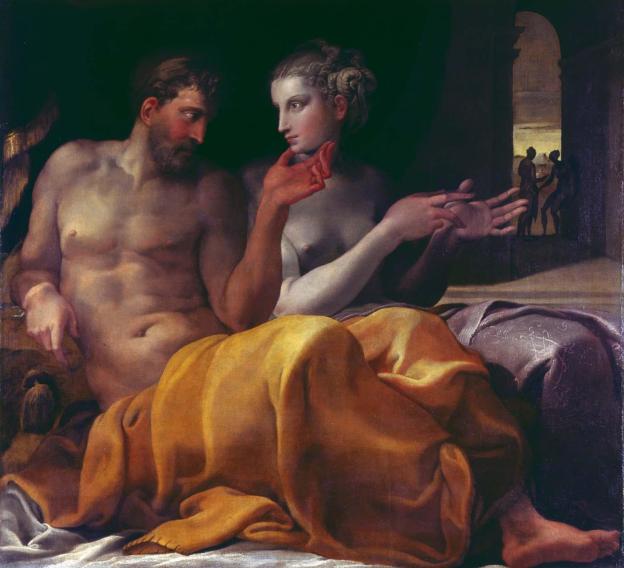
“Modern Interpretations of the Old Masters: Men Undressing for Women and Other Contemporary Perspectives”

# **Sylvia Sleigh: Challenging Traditions in Portraiture**
Sylvia Sleigh, the Welsh-American artist, made an indelible mark on the art world with her provocative and intimate portraits. Her works, particularly from the 1960s and ’70s, stand as a rejection of traditional artistic norms that favored the female nude while omitting the representation of nude male figures. By shifting the gaze and placing men in sensual, vulnerable, and often reclining poses, Sleigh challenged long-standing conventions in portraiture and art history.
## **Breaking the Boundaries of Representation**
For much of art history, the female body has been the primary subject of the nude—painted, sculpted, and objectified under the male gaze. Sleigh, however, subverted this trope. Her works confront the lack of male nudes and reimagine compositions traditionally reserved for women, placing men in relaxed, revealing, and sensual poses.
Her paintings from more than 50 years ago would have been particularly surprising to American audiences, offering them a glimpse at something previously seen as taboo: the naked bodies of contemporary men. Today, in an era where the internet provides endless exposure to the human form, her paintings still carry a distinct perspective—one that reclaims the male body through a lens of admiration and mutual respect.
## **Early Works and Artistic Evolution**
Sleigh’s early work demonstrates a psychological depth akin to British artists like Lucian Freud. In one of her notable early paintings, *At the Café* (1950), she portrays herself and her partner, critic and curator Lawrence Alloway, with an air of anxiety. This introspective style, seen in many other British painters of the time, evolves in Sleigh’s later works, becoming more fluid, bold, and liberated.
Her painting *Allan Robinson* (1968) is a key example of this transition. The subject, an artist himself, appears at ease—a subtle yet powerful statement. Unlike traditional male portraiture, which depicted men as strong, dominant, and clothed, Sleigh’s work invites viewers to gaze upon the male body in the same way that female nudes have historically been admired in art.
## **Traditional Forms with a Modern Twist**
Sleigh’s ability to reinterpret classic compositions is evident in works like *Triple Portrait of Philip Golub* (1971), which echoes Anthony Van Dyck’s famous *Triple Portrait of Charles I* (1635–36). By using a royal portrait style for a young male muse, she cleverly upends historical artistic norms.
Similarly, *Court of Pan (After Luca Signorelli)* (1973) draws inspiration from a Renaissance fresco that was destroyed during World War II. In this piece, Sleigh replaces the traditional Renaissance figures with her husband, artist Paul Rosano, and others. By inserting contemporary figures into these historic settings, she bridges past and present, demonstrating that the dialogue around representation is continuous.
## **The Role of Intimacy in Her Paintings**
What sets Sleigh’s work apart is the sense of trust and intimacy she fosters with her subjects. While traditional portraiture often distanced the viewer from the subject, Sleigh embraced a more personal approach. Her paintings are not idealized; rather, they depict real bodies with individual characteristics—tan lines, veins, and body hair—treated with the same care as the subject’s expressions.
Her subjects were often fellow artists, colleagues, and close friends—people she knew well and cared for deeply. This connection is evident in paintings like *October: Felicity Rainnie and Paul Rosano* (1974), where the figures seem almost secondary to the riot of colors and textures behind them. In *Felicity Rainnie Reclining* (1972), the richly detailed background nearly overtakes the nude figure, adding complexity to the composition.
## **A Legacy of Artistic Defiance**
While some of her later works, such as *Sean Pratt as Dorante from “The Game of Love and Chance”* (1996), feel more conventional, her earlier artistry remains groundbreaking. She didn’t merely swap genders in traditional compositions as a gimmick—she reshaped the dynamics of gaze, subjectivity, and representation.
Ultimately, Sleigh’s work is not just about who is nude, but **how** they are represented. By painting men with the same care and sensuality as women, she opened new possibilities for portraiture. Her works feel like an invitation into a world where nudity is natural, vulnerability is celebrated, and figures—whether male or female—are seen, respected, and elevated.
## **Conclusion**
Sylvia Sleigh’s paintings continue to challenge conventional portrayals of gender, beauty, and power in art history. Her work is a testament to the importance of representation and the radical idea that all bodies—male or female—deserve to be portrayed with both dignity and desire.
Her ongoing influence can be observed in contemporary